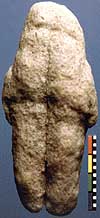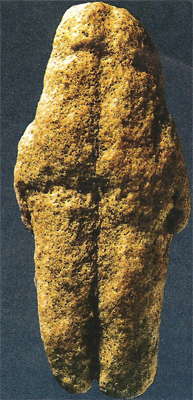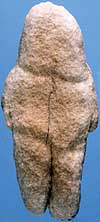Back to Don's Maps
Back to Venus figures from the Stone Age
The Tan-Tan Venus

The photo at left is of the 'front' of the figure which was found in sediments aged 300 000 and 500 000 years old, thus of similar antiquity (given the inherent dating uncertainties) to the only other such figure, the Berekhat Ram figure, dated at between 233 000 and 800 000 years old.
Photographs and text adapted from unless otherwise noted:
http://www.journals.uchicago.edu/CA/journal/issues/v44n3/033701/033701.html
CURRENT ANTHROPOLOGY Volume 44, Number 3, June 2003
The author of the article is Robert G. Bednarik, the world's foremost expert on microwear of grains as an aid to understanding the history of an artefact, and as an aid to dating the artefact.
The Tan-Tan figurine was discovered during an archaeological survey by Lutz Fiedler, state archaeologist of Hessen, Germany, in a river terrace deposit on the north bank of the River Draa a few kilometers south of the Moroccan town of Tan-Tan.
The lowest sediments contain red sands and pebbles and yields stone tools of typical Early Acheulian character. This layer is followed by an approximately 12 metre (40 feet) sequence of alluvial gravels, sands, and finer fractions of varying compositions, the lower part of which contains a rich industry of the Middle Acheulian, free of specimens of Levallois technique.
(The "Late Acheulean" is characterized by a new technique known as the Levallois (pronounced: "lev-uh-wah" or "leh-vah-wah") emerged. It was distinct enough to warrant a separate technique name, but similar enough to traditional Acheulean tools such that a separate tool industry or culture was not assigned.
The Levallois technique of the Acheulean Tool Industry/Culture dates from roughly 300 000 years ago to around 125 000 years ago . While Homo erectus made traditional Acheulean tools, the new Levallois technique is associated with the earliest Archaic Homo sapiens. Levallois tools were still hand axes; the difference is how they were manufactured: the Levallois technique represents the first attempt at mass production and standardization.)
Text in italics from: http://people.uncw.edu/albertm/ant210fall02/hstools01.htm
The figurine is from this horizon, around 1.5 m above its base or 15 m below the plain's eroded surface.

Another version of the Tan Tan Venus.
Photo: Der Spiegel 6/2004 p. 143
The antiquity of the Middle Paleolithic of the general region is on the order of 50 000 and 120 000 years, and Middle Acheulian of similar composition occurs between 300 000 and 500 000 years. The Early Acheulian industry of Morocco and the Maghreb generally is older than 500 000 years.
The stone figurine was found by Fiedler himself in situ, slightly exposed in the section, only centimetres from the nearest handaxes, occurring clearly in an undisturbed and well-stratified context of rich Middle Acheulian deposit.
The Acheulian of north-western Africa is of great significance to the study of the same industry in south-western Europe because of the likelihood that Europe was initially settled via the Strait of Gibraltar rather than via eastern Europe (Bednarik 1999 a). The identical Lower Paleolithic development in western Europe and the Maghreb, the presence of Acheulian disc beads on both sides of the western Mediterranean (Bednarik 2001 a), and the evidence of Acheulian navigation from the huge former Fezzan Lake (Bednarik 2001 b) render it very plausible that the Strait of Gibraltar was negotiated by these hominids. This possibility is supported by the significantly longer sea crossings achieved by their Indonesian contemporaries (Bednarik 1999 b). The stone tool technologies of Indonesia (such as those at Mata Menge, Boa Leza, Koba Tuwa, Ngamapa, and To'os [Bednarik and Kuckenburg 1999 ]) and northern Africa were among the most advanced at that time. The existence of the Tan-Tan figurine needs to be seen in this general context, the context of an enterprising and relatively sophisticated people.
 The photo at left is of the 'back' of the figure.
The photo at left is of the 'back' of the figure.
The Tan-Tan figurine consists of a moderately metamorphosed quartzite. It is 58.2 mm long, a maximum of 26.4 mm wide, and 12.0 mm thick and weighs roughly 10 g. The grain size is of a small range, although small local variations in average grain size do occur. Well over 80% of grains fall into the 0.10 0.25-mm fraction; there are very few smaller grains, and the larger grains appear particularly as elongate, slightly more angular forms of up to 0.6 mm. The quartz grains are generally clear, well sorted, moderately rounded, and lightly frosted. They are more tightly packed than those in the accompanying tools, which tend to have higher cement contents.
There are almost 20 minute specks of a brilliant red matter, waxy in appearance. These specks occur in minute depressions adjacent to prominent aspects of the micro-topography and are not in the larger recesses. They have been determined to be of iron and manganese.
There is no evidence that the overall form of the object was modified by human action. Evidence of impact and of crushing of quartz grains does occur, but it is entirely restricted to specific grooves in the figurine. The form of the object is attributable to the natural bedding of the initial sandstone and to weathering. Originally horizontal bedding planes formed the "arms" and the median line, including the separation of the "legs." The object is entirely the result of random natural processes. However, the grooves at roughly right angles to the bedding plane, appearing on both sides of the object and emphasizing its anthropomorphous character, are partly natural and partly artificial. Some of these defining grooves are attributable to slight variations in the petrology of the quartzite (grain orientation), some were formed by connecting natural depressions, and some were formed by percussion alone.

 The photos at left are of the grooves labelled A, B, C, D and E, F, G, H of the figure, with dots to show evidence of impact scars.
The photos at left are of the grooves labelled A, B, C, D and E, F, G, H of the figure, with dots to show evidence of impact scars.
The impact traces in five of the eight grooves suggest that they were carefully emphasized by the process described.
The Acheulian Berekhat Ram figurine, excavated in summer 1981 in the northern Golan Heights of Israel (Goren-Inbar, N. 1985. The lithic assemblages of Berekhat Ram Acheulian site, Golan Heights. Paléorient 11:7 28. ), is a basaltic tuff pebble containing scoria clasts. It has a natural form suggestive of the head, torso, and arms of a female human and bears grooves implying that the iconic properties of the object were emphasized artificially.
The argument that the Berekhat Ram pebble is a single representative of a category, thus calling its status as a figurine into question has been raised by various writers. The discovery of a second specimen is therefore of considerable significance, because it immediately reduces this concern. Not only is the second specimen presented here of very broadly the same age and certainly the same cultural provenience but its morphological similarities are such that it could easily have been modified by the same artist with similar tools. Yet it was found 4 700 km distant, in southern Morocco.
The Berekhat Ram figurine was modified by precisely the same treatment as the one from Tan-Tan, the creation or emphasis of "horizontal" grooves.